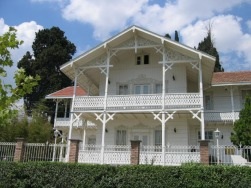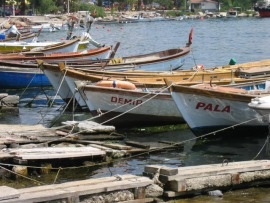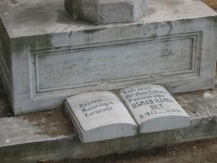Home to Osman Hamdi Bey Population: 600
Old name: Dakibyze
It isn’t always necessary to travel a long way or to undertake a complicated journey in order to get somewhere completely off the beaten track.
Take Eskihisar, for example, a pretty little harbour on the outskirts of İstanbul that receives far fewer visitors than it deserves.
And why would you want to go to Eskihisar?
Well, mainly because it was the summer home of the Turkish artist, archaeologist, museum founder and all-round Ottoman good guy, Osman Hamdi Bey.
Even if you’ve never heard of him you will almost certainly have seen one of the increasingly ubiquitous copies of his most famous painting, The Tortoise Trainer. When this was sold at auction to a member of the Koç family for $3.5 million in 2004 it went straight into the record books as the most expensive Turkish painting ever sold.
Around town
 The Osman Hamdi Bey Museum housed in a wooden waterside mansion or yali built in 1884 is the main reason to come to Eskihisar.
The Osman Hamdi Bey Museum housed in a wooden waterside mansion or yali built in 1884 is the main reason to come to Eskihisar.
Visitors can see the room where the artist used to work, still with some of its original furnishings, as well as an airy upstairs salon which might have served as his studio. This has been fitted out with mannequins to show him painting a portrait of his second wife in a yellow dress as she fills a wall basket with flowers.
The museum contains copies of many of his paintings. It’s a shame that none are originals and that none is labelled to suggest the homes of the originals, but they do make it possible to see beyond the by now somewhat hackneyed Tortoise Trainer.
Osman has been described as Turkey’s only “orientalist” artist, perhaps a consequence of his nine-year stay in Paris where he may have learnt to view the East through the same somewhat rose-tinted spectacles as his Western friends.
On the guided tour of the house (Turkish only) you will be shown how some of the paintings incorporate images of Osman himself and of his sons. There are also lovely portraits of his wives and a rather sobering picture of Gebze as it was in the 19th century – a Safranbolu lookalike and a far cry from the ugly industrial centre that it has become.
Also on display in the house are a collection of family photographs which show the lovely rose garden that adjoined the house, now sadly overgrown (although there is a pleasant tea garden and picnic area). Perhaps the most telling direct reminders of the great man are some floral door panels in the study which he probably painted himself.
In 2022 work on restoring the house began and the museum was closed to the public.
 It seems nothing short of a miracle that the fishing harbour in front of the house is still as pretty as it is, given that there is a port for boats to Topçular just around the corner. A landscaped promenade links the two, making an already appealing setting even nicer. Plenty of fish restaurants and inviting tea gardens await passing traffic. The six-lane Osman Gazi suspension bridge linking Gebze to Yalova is clearly visible from the waterftont. It opened in 2016.
It seems nothing short of a miracle that the fishing harbour in front of the house is still as pretty as it is, given that there is a port for boats to Topçular just around the corner. A landscaped promenade links the two, making an already appealing setting even nicer. Plenty of fish restaurants and inviting tea gardens await passing traffic. The six-lane Osman Gazi suspension bridge linking Gebze to Yalova is clearly visible from the waterftont. It opened in 2016.
There is, of course, an eski hisar (old castle)at Eskihisar. It looms up on the hill overlooking the bay and seems to date back to Byzantine times. From 1261 until at least 1290 it served as a prison for John IV Lascaris, seen as a potential rival to the Byzantine throne by Michael VIII Paleologos.
Unfortunately recent restoration has been crude – more of a rebuild than a restoration. However, during the summer months the sloping interior has been set up as an open-air cinema-cum-concert hall. It would be hard to imagine a lovelier setting, with the deep blue of the Sea of Marmara a constant backdrop.The view looking back from the water is even better.
Before leaving Eskihisar you should divert up a hill signposted inland to see Osman’s grave amid the pine trees. The gravestones look very like those of the Menekşe emirs of Beçin, near Milas; appropriate perhaps for a man so in love with the past who died in 1910.
The famous Tortoise Trainer now hangs in pride of place in İstanbul’s Pera Museum. Its subject matter seems, at first, rather unlikely. Who was this turbaned trainer with his flute behind his back? And why would anyone want to train tortoises anyway?
The usual story links the picture to a pretty-sounding Ottoman habit. Back in the early years of the 18th century – the so-called Tulip Age, when Sultan Ahmed III was on the throne – garden parties were often held at the Topkapı Palace to show off the sultan’s collection of rare and expensive tulips. To illuminate them, tortoises would trundle round the grounds with candles attached to their shells, hence the need for a trainer to get them used to the idea.
According to the museum it’s more likely, if less romantic, that Osman was inspired by a report about tortoise trainers that he had read in an imported Korean newspaper.
More of Hamdi Bey’s paintings together with information on his life can be found on the top floor of the İstanbul Ressim ve Heykel Müzesi (Painting and Sculpture Museum) beside the Galataport in Tophane.
Sleeping
Most people will visit on a day trip from İstanbul although there is one lovely hotel in Eskihisar.
Club Atabey Delightfully secluded 25-room hotel with a pool, private beach and great sea views just east of the castle. Tel: 0262-655 5854
The Marmaray from İstanbul ends at Gebze. You’ll find buses for the short run down to Eskihisar just outside the station.
Frequent ferries make the short crossing of the Gulf of İzmit to Topçular for onward travel.
Day trip destinations
Read more: A Forgotten Ferry Route


